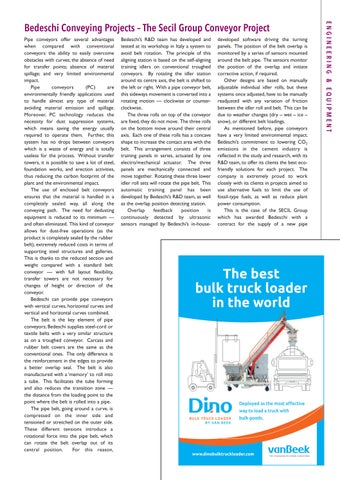Pipe conveyors offer several advantages when compared with conventional conveyors: the ability to easily overcome obstacles with curves; the absence of need for transfer points; absence of material spillage; and very limited environmental impact. Pipe conveyors (PC) are environmentally friendly applications used to handle almost any type of material avoiding material emission and spillage. Moreover, PC technology reduces the necessity for dust suppression systems, which means saving the energy usually required to operate them. Further, this system has no drops between conveyors which is a waste of energy and is totally useless for the process. Without transfer towers, it is possible to save a lot of steel, foundation works, and erection activities, thus reducing the carbon footprint of the plant and the environmental impact. The use of enclosed belt conveyors ensures that the material is handled in a completely sealed way, all along the conveying path. The need for dedusting equipment is reduced to its minimum — and often eliminated. This kind of conveyor allows for dust-free operations (as the product is completely sealed by the rubber belt), extremely reduced costs in terms of supporting steel structures and galleries. This is thanks to the reduced section and weight compared with a standard belt conveyor — with full layout flexibility, transfer towers are not necessary for changes of height or direction of the conveyor. Bedeschi can provide pipe conveyors with vertical curves, horizontal curves and vertical and horizontal curves combined. The belt is the key element of pipe conveyors; Bedeschi supplies steel-cord or textile belts with a very similar structure as on a troughed conveyor. Carcass and rubber belt covers are the same as the conventional ones. The only difference is the reinforcement in the edges to provide a better overlap seal. The belt is also manufactured with a ‘memory’ to roll into a tube. This facilitates the tube forming and also reduces the transition zone — the distance from the loading point to the point where the belt is rolled into a pipe. The pipe belt, going around a curve, is compressed on the inner side and tensioned or stretched on the outer side. These different tensions introduce a rotational force into the pipe belt, which can rotate the belt overlap out of its central position. For this reason,
Bedeschi’s R&D team has developed and tested at its workshop in Italy a system to avoid belt rotation. The principle of this aligning station is based on the self-aligning training idlers on conventional troughed conveyors. By rotating the idler station around its centre axis, the belt is shifted to the left or right. With a pipe conveyor belt, this sideways movement is converted into a rotating motion — clockwise or counterclockwise. The three rolls on top of the conveyor are fixed, they do not move. The three rolls on the bottom move around their central axis. Each one of these rolls has a concave shape to increase the contact area with the belt. This arrangement consists of three training panels in series, actuated by one electro/mechanical actuator. The three panels are mechanically connected and move together. Rotating these three lower idler roll sets will rotate the pipe belt. This automatic training panel has been developed by Bedeschi’s R&D team, as well as the overlap position detecting station. Overlap feedback position is continuously detected by ultrasonic sensors managed by Bedeschi’s in-house-
developed software driving the turning panels. The position of the belt overlap is monitored by a series of sensors mounted around the belt pipe. The sensors monitor the position of the overlap and initiate corrective action, if required. Other designs are based on manually adjustable individual idler rolls, but these systems once adjusted, have to be manually readjusted with any variation of friction between the idler roll and belt. This can be due to weather changes (dry – wet – ice – snow), or different belt loadings. As mentioned before, pipe conveyors have a very limited environmental impact. Bedeschi’s commitment to lowering CO2 emissions in the cement industry is reflected in the study and research, with its R&D team, to offer its clients the best ecofriendly solutions for each project. The company is extremely proud to work closely with its clients in projects aimed to use alternative fuels to limit the use of fossil-type fuels, as well as reduce plant power consumption. This is the case of the SECIL Group which has awarded Bedeschi with a contract for the supply of a new pipe
The best bulk truck loader in the world
Deployed as the most effective way to load a truck with bulk goods.
www.dinobulktruckloader.com
ENGINEERING & EQUIPMENT
Bedeschi Conveying Projects – The Secil Group Conveyor Project
